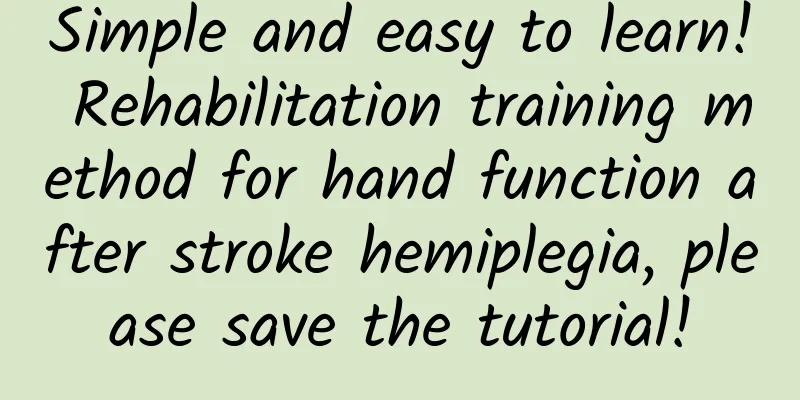Simple and easy to learn! Rehabilitation training method for hand function after stroke hemiplegia, please save the tutorial!

|
Many stroke patients will have varying degrees of hemiplegia after their condition stabilizes, among which hand dysfunction has a great impact on the patient's daily life, such as dressing, eating, washing and other basic activities become difficult. Therefore, effective hand function rehabilitation training is crucial to improving the quality of life of stroke hemiplegia patients. Below, Yongzhou Lingling District Traditional Chinese Medicine Hospital will give you a detailed introduction to several common hand function rehabilitation training methods after hemiplegia due to stroke. It’s science time! 1. Passive activity training In the early stage of hemiplegia after stroke, the patient's hand muscles are extremely weak or even completely lose the ability to move autonomously. At this time, passive movement training is a critical link , which helps patients move their hand joints with the assistance of external force. The principle is to maintain the normal range of motion of the joints, promote the circulation of synovial fluid, provide nutrition for the articular cartilage, thereby maintaining the flexibility of the joints, preventing joint contracture and muscle atrophy caused by long-term inactivity, and laying a good foundation for subsequent active movement training. Specific operations Therapists or family members help patients to move their hand joints. Wrist flexion and extension: Gently hold the patient's wrist, slowly bend the wrist upward (dorsiflexion), feel the extension of the wrist joint, hold for 3-5 seconds, then slowly bend it downward (palmar flexion), and repeat 10-15 times. Wrist rotation: Hold the patient's wrist and slowly rotate it clockwise and counterclockwise, 10-15 times in each direction, allowing the patient to feel the full range of motion of the wrist joint. Finger flexion and extension: Starting from the thumb, hold the patient's fingers one by one, slowly straighten them, and then bend them. Repeat 10-15 times for each finger. Be careful to be gentle and avoid excessive force. Finger adduction and abduction: Help the patient bring the fingers together as much as possible (adduction), and then spread them out to the sides as much as possible (abduction). Repeat 10-15 times for each finger. 2. Bobath Handshake Training Training Purpose The Bobath handshake is a simple but highly effective training method that aims to inhibit the flexor spasm pattern of the upper limbs . After hemiplegia caused by a stroke, patients often experience flexor spasms in their upper limbs, leading to abnormal postures such as finger flexion and upper limb adduction. The Bobath handshake can activate the upper limb extensors through specific postures and movements, promote the normal activity of the extensors, improve the movement pattern of the upper limbs, and thus enhance the control ability of the affected upper limb and improve the coordination of hand functions. Procedure The patient crosses his fingers and places the affected thumb on top of the healthy thumb. This is the key point to prevent the affected thumb from being wrapped by the healthy fingers and affecting the training effect. Then straighten both upper limbs and raise them as high as possible to reach above the head. Hold for 3-5 seconds each time, then slowly lower them. Repeat 10-20 times, 3-4 sets per day. During the process, pay attention to keeping the upper limbs straight and avoid bending. 3. Grip Training Training significance When the patient has a certain muscle strength in his hand, grip training becomes particularly important. In daily life, gripping is one of the most frequently used functions of the hand, such as holding a pen to write, holding a cup to drink water, etc. Through grip training, the muscle strength of the hand can be enhanced, especially the flexor and extensor strength of the fingers, while improving the flexibility and coordination of the fingers, so that patients can better complete various gripping movements and restore their daily living ability. Training Methods Prepare some objects of different sizes, shapes and textures, such as sponge balls, wooden blocks, plastic bottles, etc. Ask the patient to grasp these objects with the affected hand, starting with large and light objects, because large objects are easier to grasp and require relatively less hand strength. As the training progresses, gradually transition to small and heavy objects. Try to hold the grasp for a certain time, such as 5-10 seconds, then release and repeat. For example, first let the patient grasp a large sponge ball to feel the grasping action and strength, and then try to grasp a smaller wooden block after adapting. 4. Occupational therapy training Concept and function Occupational therapy is aimed at training patients' daily living abilities, and improves hand function through some purposeful activities. It is not only about training the motor function of the hands, but more importantly, it integrates the training into daily life scenes to improve patients' ability to take care of themselves and participate in social activities. At the same time, these activities can also train patients' attention, cognitive ability, and hand-eye coordination. Specific activities Jigsaw puzzles: Prepare puzzles that are suitable for the patient's difficulty, and let the patient observe and think, and correctly put the puzzle pieces together. In this process, the patient needs to pick up the puzzle pieces with his hands and place them accurately in the corresponding positions, so as to train his hand-eye coordination ability and shape recognition ability. Building blocks: Patients build blocks one by one, and can build in a certain shape or pattern, such as building a small house. Building blocks can exercise the fine motor skills and spatial perception of the hands, while cultivating the patient's patience and creativity. Knitting: Use yarn and knitting needles to have the patient perform simple knitting activities, such as knitting the edge of a scarf. During the knitting process, the fingers need to continuously perform actions such as winding the thread and picking up the needle, which can effectively exercise the flexibility and coordination of the fingers. Paper cutting: The patient uses scissors to cut paper into various shapes, such as circles, triangles, etc. Paper cutting activities can improve hand control and hand-eye coordination, while allowing patients to feel the changes in different shapes. According to the patient's specific situation, choose the appropriate occupational therapy program. Each training time is 20-30 minutes and is performed 1-2 times a day. 5. Sensory Training Sensory impairment The hands of stroke hemiplegic patients are often accompanied by sensory impairment, such as decreased tactile sensation, which may make them unable to accurately perceive the shape and texture of objects; abnormal temperature sensation, which may make them insensitive to cold and heat, and easily cause burns or frostbite. These sensory impairments seriously affect the patient's hand operation ability and life safety, so sensory training is an indispensable part of the rehabilitation process. Training Method Tactile training: Use items of different textures (such as towels, sandpaper, silk, etc.) to gently rub the patient's palms and fingers, and ask the patient to close his eyes and feel different tactile stimulations. For example, first wipe gently with a soft towel, then rub gently with rough sandpaper, and ask the patient how they feel. Rub each texture for 1-2 minutes each time, alternating. Temperature perception training: prepare a basin of cold water and a basin of warm water (the water temperature should be appropriate to avoid scalding or frostbite the patient). Soak the patient's hands in the cold water for 3-5 seconds, then quickly soak them in warm water for 5-8 seconds, and so on. Each training session lasts 15-20 minutes, 1-2 times a day, to help patients restore their ability to perceive temperature. The rehabilitation training of hand function after stroke hemiplegia is a long and systematic process, which requires the joint efforts of patients, family members and medical staff. During the rehabilitation training process, a personalized training plan should be formulated according to the specific situation of the patient, and the training should be carried out step by step. At the same time, attention should be paid to the safety of the training to avoid injuries caused by excessive training. I believe that through scientific and effective rehabilitation training, the hand function of hemiplegic stroke patients will be effectively improved and their quality of life will be significantly improved. Hunan Medical Chat Special Author: Long Yingshan, Lingling District Traditional Chinese Medicine Hospital of Yongzhou City Follow @湖南医聊 to get more health science information! (Edited by Wx) |
<<: Is nighttime bruxism an "invisible tooth killer"? You must know these things!
>>: Is dysmenorrhea really hereditary?
Recommend
What to do if you have miscarriage and uterine prolapse
In today's society, women will go to the hosp...
Can I still go to Korea due to the epidemic? When will the epidemic in Korea end?
The epidemic in South Korea is so serious that pe...
Is moderate cervical erosion difficult to treat?
Many women usually have some gynecological proble...
Social Media: COVID-19 Impact Report
Socialbakers has released a new report, “Social M...
I, the rat, want to "turn green", and my cells grow stronger to show miracles|Expo Daily
I, the rat, want to "turn green", and m...
What can chestnuts be eaten with to nourish the kidneys? How to eat chestnuts to nourish the kidneys
Nuts are a popular food because they are very del...
Can I exercise after having sex during ovulation?
Can we exercise after having sex during ovulation...
Is it normal to have breast tenderness 10 days before your period?
Menstruation is an important period that comes ev...
How to distinguish the gender of the baby in the early stages of pregnancy
Many expectant mothers, pregnant fathers and even...
How to heal cesarean section wound quickly
Caesarean section is more common among modern wom...
What to do about menopausal endocrine disorders
Women will experience menopause when they reach a...
Low eosinophil count in pregnant women
During the pregnancy process, women need to under...
Standard arm size for girls
In addition to the golden ratio of the belly butt...
What to do if you have vaginal polyps
Most patients with polyps in the vagina do not ha...
Does the early or late fetal movement have anything to do with gender?
Can you tell whether the baby is a boy or a girl ...









